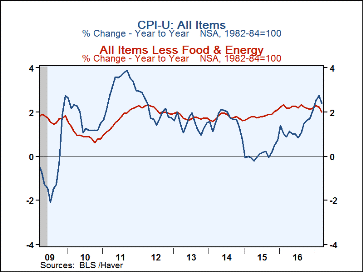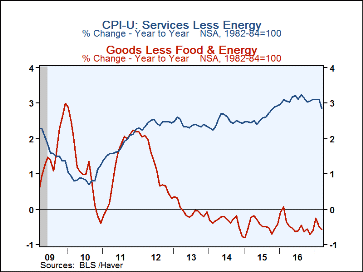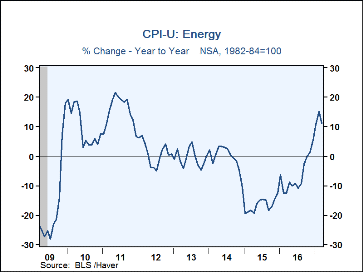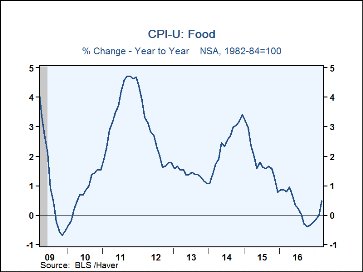 Global| Apr 14 2017
Global| Apr 14 2017U.S. CPI Decline Reflects Broad-Based Weakness
by:Tom Moeller
|in:Economy in Brief
Summary
Pricing pressure evaporated last month. The Consumer Price Index fell 0.3% during March, the first monthly decline since February 2016. Prices were expected to remain stable in the Action Economic Forecast Survey. The breadth of the [...]
Pricing pressure evaporated last month. The Consumer Price Index fell 0.3% during March, the first monthly decline since February 2016. Prices were expected to remain stable in the Action Economic Forecast Survey. The breadth of the price weakness was evident in a 0.1% slip in prices excluding food & energy, where a 0.2% increase had been anticipated. The y/y gain in core pricing power declined to 2.0%, its weakest annual rate of increase since November 2015.
Weakness in core pricing power was most evident in, but not limited to, a 0.3% decline in goods prices less food & energy. Furniture & bedding costs fell 0.8% (-1.7% y/y) after a 0.4% rise. Apparel prices fell 0.7% (+0.6% y/y) and reversed the February increase. Used car prices weakened 0.9% (-4.7% y/y), the third consecutive monthly decline. New car & truck prices eased 0.3% (+0.2% y/y) after a 0.2% drop. Recreation goods prices fell 0.3% (-3.3% y/y), led by a 0.8% decline (-18.9% y/y) in television prices. To the upside, household appliance prices rose 0.5% (-2.7% y/y) following a 0.4% rise. In the medical care sector, goods prices gained 0.2% (3.9% y/y) following a 0.2% decline.
Prices in the service sector also were weak. A 0.1% slip (+2.9% y/y) followed four straight months of 0.3% increase. The decline mostly reflected a 5.0% drop (NSA) in telephone services prices (-7.8% y/y). Other service price categories showed minimal strength. A 0.1% rise in shelter costs (3.5% y/y) followed six years of stronger monthly increases. Owners' equivalent rent of primary residences gained 0.2% (3.5% y/y), but the cost of lodging away from home fell 2.4% (+0.4% y/y). Medical care services prices ticked just 0.1% higher (3.4% y/y) after four months of 0.2% increase. Transportation services prices increased 0.4% (3.8% y/y) following four months of stronger increases. Recreation services prices rose 0.2% (3.5% y/y) after a 0.9% rise. Tuition & other school fees remained steady (2.4% y/y).
Energy prices exhibited an outsized 3.2% decline (+10.9% y/y) that followed a 1.0% fall. It was paced by a 6.2% drop in gasoline prices that still were 19.9% higher y/y. Fuel oil & other fuel prices fell 4.1% (+17.2% y/y). Natural gas prices eased 0.8% (+10.3% y/y) following two months of 1.5% increase. Electricity costs slipped 0.1% (+1.6% y/y) after a 0.8% rise.
Food prices were the only major category where consumer prices rose. A 0.3% increase (0.5% y/y) was the strongest increase since September 2015. Fruit & vegetable prices surged 1.6% (-1.8% y/y) after a 0.7% rise. Meat prices jumped 0.7% (-2.3% y/y) following a 0.3% increase. Cereal & bakery product prices rose 0.3% (-0.4% y/y) and the cost of eating out rose 0.2% (NSA, 2.4% y/y) for a second month. This strength was accompanied by a 1.8% decline (-21.8% y/y) in egg prices. Dairy products prices fell 0.6% (+0.2% y/) following two months of 0.8% increase. Nonalchoholic beverage prices eased 0.1% (0.2% y/y) following a 1.5% jump.
The consumer price data is available in Haver's USECON database while detailed figures can be found in CPIDATA. The expectations figure is from Action Economics and is found in the AS\1REPNA database.
The Large Unmet Demand for Housing from the Federal Reserve Bank of Kansas City can be found here.
| Consumer Price Index, All Urban Consumers (%) | Mar | Feb | Jan | Mar Y/Y | 2016 | 2015 | 2014 |
|---|---|---|---|---|---|---|---|
| Total | -0.3 | 0.1 | 0.6 | 2.4 | 1.3 | 0.1 | 1.6 |
| Total less Food & Energy | -0.1 | 0.2 | 0.3 | 2.0 | 2.2 | 1.8 | 1.7 |
| Goods less Food & Energy | -0.3 | -0.0 | 0.4 | -0.6 | -0.5 | -0.5 | -0.3 |
| Services less Energy | -0.1 | 0.3 | 0.3 | 2.9 | 3.1 | 2.6 | 2.5 |
| Food | 0.3 | 0.2 | 0.1 | 0.5 | 0.3 | 1.9 | 2.4 |
| Energy | -3.2 | -1.0 | 4.0 | 10.9 | -6.6 | -16.7 | -0.3 |
Tom Moeller
AuthorMore in Author Profile »Prior to joining Haver Analytics in 2000, Mr. Moeller worked as the Economist at Chancellor Capital Management from 1985 to 1999. There, he developed comprehensive economic forecasts and interpreted economic data for equity and fixed income portfolio managers. Also at Chancellor, Mr. Moeller worked as an equity analyst and was responsible for researching and rating companies in the economically sensitive automobile and housing industries for investment in Chancellor’s equity portfolio. Prior to joining Chancellor, Mr. Moeller was an Economist at Citibank from 1979 to 1984. He also analyzed pricing behavior in the metals industry for the Council on Wage and Price Stability in Washington, D.C. In 1999, Mr. Moeller received the award for most accurate forecast from the Forecasters' Club of New York. From 1990 to 1992 he was President of the New York Association for Business Economists. Mr. Moeller earned an M.B.A. in Finance from Fordham University, where he graduated in 1987. He holds a Bachelor of Arts in Economics from George Washington University.










